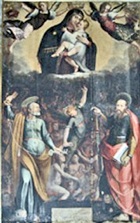

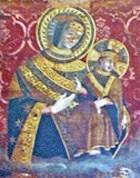
Madonna di Constantinopoli (detail), attributed to il Fantino
Pinacoteca, Bevagna
Ascensidonio Spacca was born in Bevagna. He was influenced by Dono Doni: in turn he had a formative influence on Andrea Camassei, whom he designated as his heir in a will dated 1627. All his known works were executed in Umbria.
Bevagna
Works in the Pinacoteca
The Pinacoteca contains the following works by or attributed to il Fantino:
Scenes from the life of the Blessed James Bianconi (1589)
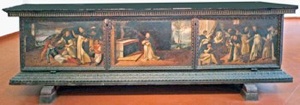
These three scenes adorn the front of the wooden sarcophagus that contained the relics of the Blessed James Bianconi in SS Domenico e Giacomo in the period 1589-1686. The scenes depict the Blessed James:
-
✴resuscitating the mason Maurizio who had fallen from the campanile of the church;
-
✴praying before the Crucifix in the church that sprays him with blood; and
-
✴turning water from the fountain in the adjacent cloister into wine.
Madonna di Constantinopoli with saints (1609)
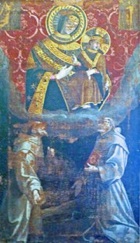
Crucifixion (1609)
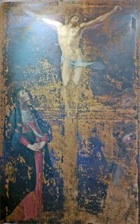
Annunciation (ca. 1600)
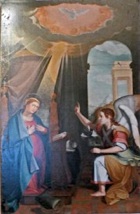
St Vincent Ferrer (ca. 1600)
This damaged altarpiece is of unknown (but certainly Dominican) provenance.
Fresco in Santa Margherita (1592)
This fresco, which is signed il Fantino, is apparently in a niche behind the high altar of Santa Margherita. It depicts
-
✴the deposition of Christ from the cross (above); and
-
✴the Madonna and Child with SS Apollonia and Catherine of Alexandria.
Works in San Francesco
The church of San Francesco contains the following works by or attributed to il Fantino:
Trinity and the Virgin with Saints (16th century)
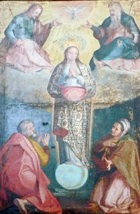
Frescoes in Cappella Ciccoli (late 16th century)
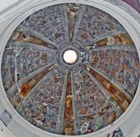
-
✴a fresco (1594) of the Pietà on the monument to Antonio and Francesco Ciccoli, which is signed and dated by inscription (not visible during my visit of April 2010); and
-
✴the fresco in the cupola depicting the hierarchy of angels, which is attributed to il Fantino.
The damaged altarpiece of the Crucifixion, with St Francis kneeling at the foot of the cross, is sometimes attributed to him.
Altarpieces in Santa Maria delle Grazie
Il Fantino was documented as head of the workshop at the church of Santa Maria delle Grazie in 1617. The works there that associated with him are:
-
✴an altarpiece (1603) the Madonna di Constantinopoli with St Joseph and the donor, Crispolto Giorgi; and
-
✴other altarpieces (early 17th century) that are attributed to him:
-
•the Annunciation, on the 1st altar on the right;
-
•St Charles Borromeo in prayer, on the 1st altar on the left; and
-
•the Assumption of the Virgin, on the 2nd altar on the left, which is in two parts:
-
-the assumption itself; and
-
-the Apostles at the empty tomb.
Altarpieces in SS Domenico e Giacomo (ca. 1600)
Four altarpieces in SS Domenico e Giacomo are attributed to il Fantino:
-
✴Trinity with SS Stephen, Catherine of Alexandria, Dominic, Francis, Clare and Lawrence is in the 5th bay on the right.
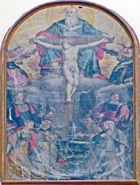
-
✴The Madonna del Rosario is in the 3rd bay on the right. A number of Dominican monks and nuns receive rosaries from the Madonna and Child, while below, a bishop and a group of nobles kneel in front of the choir of a church. The secular group includes two small children and a baby in the arms of its nurse.
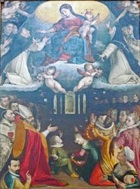
-
A very similar panel in Spello (below) is more specific:
-
•the bishop at Bevagna is replaced by Pope Pius V, the Dominican pope who instituted the feast of the rosary after the Battle of Lepanto (1571); and
-
•the choir is specifically that of Santa Maria Maggiore, the church for which the panel was painted.
-
It is possible that the panel at Bevagna was a generalised copy of that at Spello.
-
✴The Madonna di Constantinopoli with SS Charles Borromeo and Catherine of Alexandria is in the 1st bay on the right.
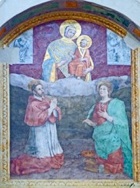
-
✴St Hyacinth’s vision of the Madonna and Child is in the 2nd bay on the left.
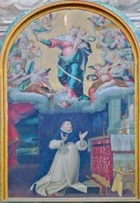
Works in the Chiesa dell’ Annunziata
The Chiesa dell’ Annunziata (outside Bevagna) contains two works that are attributed to il Fantino:
-
✴a fresco (late 16th century) which depicts the Madonna and SS John the Evangelist and Francis, with God the Father in the lunette, forms the backdrop to the Crucifix (early 16th century) on the altar of the 1st chapel on the left, which belonged to the Petrucci family; and
-
✴an altarpiece (17th century) of the Incredulity of St Thomas is in the 1st chapel on the right, which belonged to the Antici family.
Bettona
Madonna and Child with saints (1615)
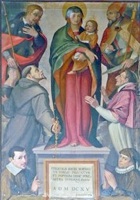
Foligno
View of Foligno (1602)

Michele Faloci Pulignani documented and illustrated this long panel in his guide to Foligno (1907), when it was “near the parish church at Cave [di Foligno]”. He recorded that Ascensidonio Spacca, il Fantino had painted it in 1602. It depicts the view of the city from Porta Romana in the 17th century. Two features of it support the reported date of 1602:
-
✴the arms of Pope Clement VIII (1592-1605) can be seen on Porta Romana; and
-
✴it also depicts the cupola of the Duomo, which was completed in 1602.
The panel is now in the Pinacoteca Civica.
This panel was documented again in 1913 as one of three works that il Fantino had executed in Foligno: the other two depicted:
-
✴the Madonna of the Rosary; and
-
✴St Antony [of Padua ?] and scenes from his life.
Emanuela Cecconelli (referenced below, at pp. 362-6) associated the former with a documented but now lost panel (1602) by il Fantino from the Cappella del Rosario of San Domenico, which depicted the Madonna of the Rosary and SS Dominic and Catherine of Alexandria. She suggested that this lost panel of the Madonna of the Rosary and the surviving panel of a view of Foligno originally formed a single work in the Cappella del Rosario of San Domenico.
Scenes from the Life of St Antony (17th century)
This fresco was documented in 1872 on the wall behind the high altar of Santa Maria di Betlem, with an attribution to il Fantino. What remains of this church is now part of a private residence, and it is not known whether the fresco survives there.
Montefalco
San Francesco, Cappella Bontadosi
Bishop Clemente Bontadosi, who was the Franciscan Provincial Minister for Umbria in 1568-71 and Minister General of the Order in 1584-6, commissioned the following works in the ex- Cappella Bontadosi in San Francesco that are attributed to il Fantino:
Immaculate Virgin with saints (1584-6)
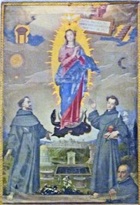
Frescoes (1589)
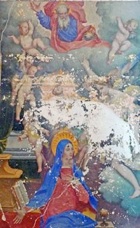
-
✴SS Bonaventure and Clare, to the sides of the entrance; and
-
✴four scenes from the life of the Virgin:
-
•her presentation at the Temple (on the left), with the adoration of the Magi below; and
-
•the Annunciation (on the right, illustrated here), with the adoration of the shepherds below.
Spello
Scenes from the life of the Virgin (1590)
These frescoes in the choir of Santa Maria di Vallegloria, which are signed by il Fantino and dated by inscription, depict:
-
✴the birth of the Virgin;
-
✴the Annunciation; and
-
✴the Visitation.
Madonna del Rosario (ca. 1590)
This panel from Santa Maria Maggiore, which is attributed to il Fantino, was documented following the Apostolic Visit of 1610, when it was on the Altare del Rosario, to the right of the entrance. It was removed when the church was re-modeled in 1644-90 and is now in the Pinacoteca Comunale. [It was not displayed in 2009]
The panel depicts SS Dominic, Peter Martyr and Catherine of Siena and another female Dominican saint receiving rosaries from the Madonna and Child while, below, a pope and a group of nobles kneel in front of the choir of a church that is clearly identifiable as Santa Maria Maggiore. A small coat of arms on the cope of the papal figure identify him as the Dominican Pope Pius V, who instituted the feast of the rosary after the Battle of Lepanto (1571).
This panel was probably executed after the formation of the Society of the Rosary at Santa Maria Maggiore in 1590. The description of the panel in 1610 identifies the lay people depicted in it as members of this society. This group includes two small children and a baby in the arms of its nurse. [This panel was not displayed in 2009]
The panel in Spello probably provided the model for the similar altarpiece in SS Domenico e Giacom, Bevagna (above), which has an unidentified bishop instead of a specific pope and a generalised rather than a specific church environment.
Annunciation (1591)
This altarpiece on the Altare di San Michele on the right wall of San Gregorio Magno, which is dated by inscription, is attributed to
Madonna and Child with saints (1584)
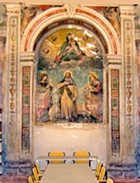
It was while executing this commission in 1594 that il Fantino was called to Sant’ Andrea to sketch an ancient image of the Blessed Andrew Caccioli that was believed to be above his tomb: the image itself was destroyed in order that the relics could be retrieved and formally recognised. The aged Il Fantino provided this information in his evidence in the process for the canonisation of the Blessed Andrew in 1625-7.
Frescoes (1589)
Some of the allegorical figures in the frieze of the Sala degli Zuccari, Palazzo Comunale Vecchio have recently been attributed to il Fantino. (The other frescoes in the frieze are traditionally (but unreliably) attributed to the workshop of Federico Zuccari).
Trevi
Works in San Martino
Works by il Fantino in San Martino comprise:
-
✴an altarpiece of the Immaculate Conception (1592) commissioned by Girolamo Fabri, which was originally in the 1st chapel on the right and is now on the high altar;
-
✴a fresco (1601) of the Last Supper in the old refectory; and
-
✴frescoes (1601) in the cloister of the stigmatisation of St Francis and 26 tondi containing Franciscan saints.
Madonna and Child with saints (ca. 1620)
